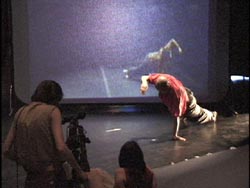

MenuWord/ Phrase Index Cellbytes Home Documentation Introduction Streaming Rehearsals Research Presentations |
- |
Compositional Strategies and MethodologiesA list of some early choregraphic starting points: Thursday 20 July
Question #14: write about a few of the compositional strategies you are using either as a choreographer or as a media/ technical artist. Are there differences between analog and digital strategies? Answer #1: I am coming at this from two different directions. Firstly: Psychological. Because of the time constraints, I have had to constantly remind myself that the end product will not be perfect. Once reminded, I need to "ride the wave" and CONSTANTLY assure the dancers that it all is good and the project is about process and not as much about product! It is okay to make mistakes while performing (a concept difficult to grasp as a performer). Then, somehow give the dancers a handle on ALL the movement material they need to know -- when and where as much as possible. Secondly: Choreographic. Instead of thinking of creating one work at a time I have to think of creating three works at the same time. I actually love the fact that this process allows me to do this. In working with one site I often have to edit out images or ideas I want in a dance (for one reason or another). This process allows me to incorporate at least three separate perspectives on one content idea. (Jennifer Tsukayama) |
- |
Images virtual partners
virtual partners
|